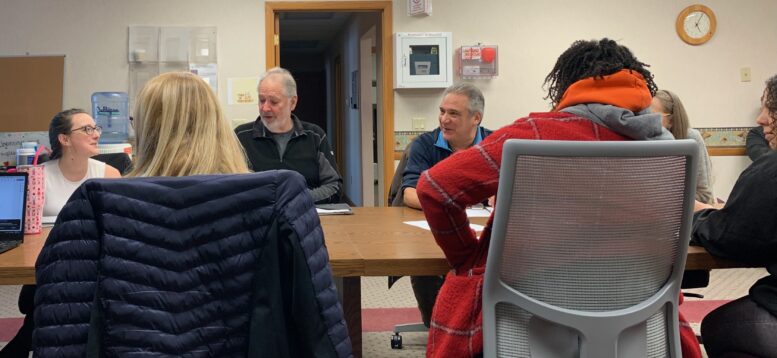By JULIE CARLE
BG Independent News
A change in the way the Ohio Department of Mental Health and Addiction Services awards funds to address the overdose crisis throughout the state caused some confusion and scrambling for the Wood County Alcohol, Drug Addiction and Mental Health Services Board and partner agencies.
The focus of the state’s State Opioid and Stimulus (SOS) grants for the current fiscal year, which started Sept. 30, 2024, was changed to fund projects for one-time only and for a one-year period. The state department explained on its website: “For projects that will require ongoing support beyond the Year One Project Period, applicants should prioritize projects for which long-term funding sources can be identified to sustain operations.”
The state funding decisions, referred to as the “SOS debacle” several times during the recent WCADAMHS board meeting, resulted in some eliminations and changes in budgets for several Wood County service providers.
The total impact to Wood County was a loss of approximately $900,000, down from $1.5 million, said WCADAMHS Finance Director Julie Launstein.
Executive Director Amanda Kern said with the change, no providers are fully funded for SOS programs. Across the state, counties saw reductions ranging between 30% and 50%. The decisions were based on criteria such as previous success rates and locations that had high rates of overdoses.
“We are contributing to a couple of programs, and some are choosing to use their own SOS funding even though it was a reduced amount,” she said. “Everyone got creative in different ways.”
“It’s not just a clear, clean-cut elimination,” Kern said. The county board used other state dollars to help with existing opioid and stimulus programs that weren’t funded, since the changes came after the start of the county board’s fiscal year.
“We had to go program line by program line and work with agencies on what they were doing with the funding,” Kern added. “The awards were made not against our applications, but the state said, ‘Here’s a percentage of what you asked for.’”
“Also, it took several months for the department to get their answers out,” Launstein said. The agencies “had to turn in what they were doing with those awards, and then we were shoring up programs and funding streams that needed to be shored up.”
Some providers were able to find some cost savings in other places, she added.
“We anticipate there will be changes to this type of funding coming down next fiscal year. It’s just unfortunate that it changed in the middle of our fiscal year,” Kern said.
One of the repercussions of the grant decisions for Wood County was the closure of the recovery house in Cygnet, operated by the Zepf Center.
“Are there other recovery programs in Wood County?” asked board member Erica Parish.
“We used to have two and then one—the Cygnet house—and now we have none,” said Kern. “The decision came with the determination of the grant funding they had received. No one was funded at the full amount, so everyone had to make some tough decisions.”
Without a recovery house in the county, the WCADAMHS board is working with a couple of agencies outside of the county to set up day rates, similar to the contracts they board has for hospital or adult care facilities’ bed days.
With contracts for recovery program bed days “we can refer folks and still have placement payments,” Kern said. “The change will also mean when we put together the system of care budget for next fiscal year, we will likely have a line separated for that (recover day bed) item because we’ve lost the resources.”
The Zepf Center still is the only provider in the county that provides methadone treatment for Wood County clients, Kern added.
Because of the change in Ohio Mental Health and Addiction Services’ issuance of state opioid and stimulant response, the board approved revised contracts for the following agencies to provide a maximum amount payable: Wood County Educational Services Center—$1,057, 509.96; Harbor— $3,637,151.51; OhioGuidestone—$397,244.51; Unison—$1,686,969.01; and Zepf Center—$342,154.47
Oversight committee established
The board will move forward with a new oversight committee that replaces the program outcomes, finance, and administrative committees.
“It will be the only other standing committee according to the bylaws,” reported Frank McLaughlin, board chair.
The committee, which will meet at least quarterly, will implement evaluations of services, review agency outcomes, provide oversight of all board financial and budgetary affairs, and review board policies as needed.
Members of the committee currently include committee Chair Matt Battiato and members Karen Baron, Katina Bostic, Leslie Miller, and Erica Parish.
In other business, the board:
- Welcomed Lindsay Durham to the board and Jodie Chappius as the system navigator for the new county program funded by the Department of Homeland Security grant for Targeted Violence and Terrorism Prevention.
- Learned the WCADAMHS website will be updated soon to improve accessibility and “make sure anybody who reaches out for help can use our website to access that help,” Kern said.
- Heard the county’s recent cybersecurity attack hindered the board’s bill paying process, which delayed approval of November and December bills until the February board meeting.
- Discussed the board’s final processes for becoming Culture of Quality accredited. The rigorous process for the accreditation, once achieved improves patient outcomes, staff focus and facility services.





